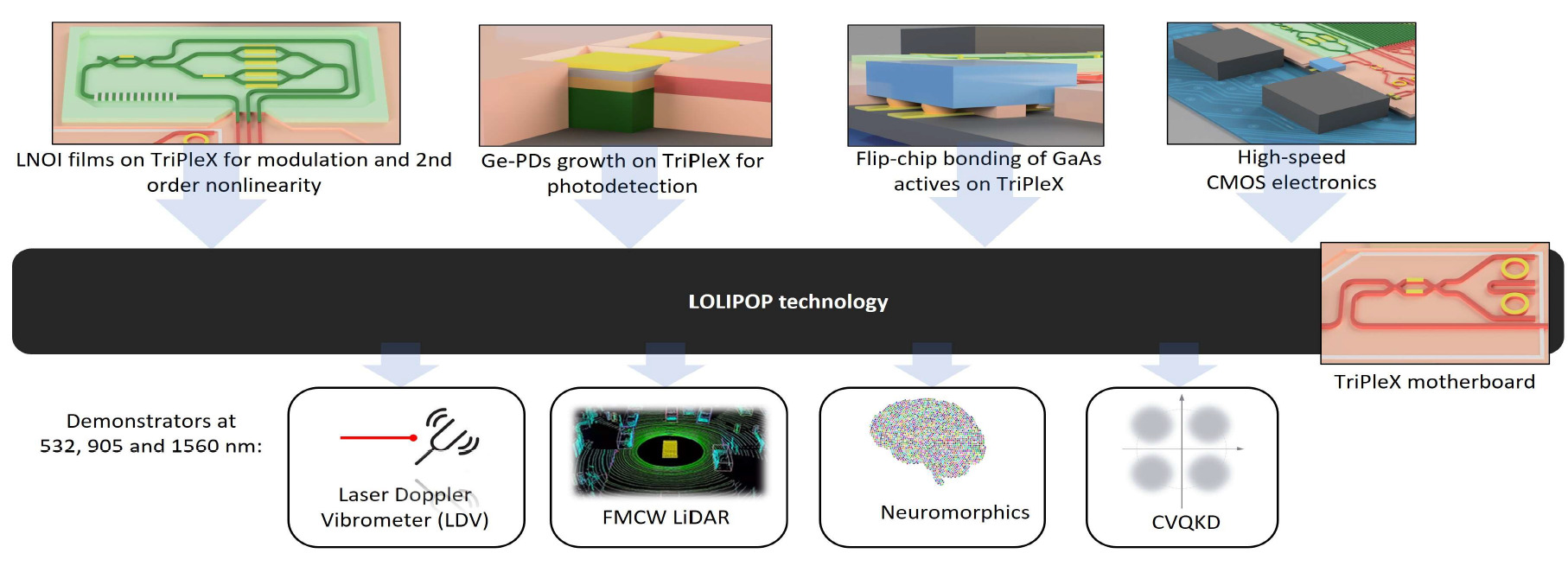About Project LOLIPOP:
Despite huge progress in photonics, extended spectral bands at wavelengths below 1100 nm remain heavily underserved in terms of integration solutions. At the same time, silicon nitride is booming, and lithium niobate is making an impressive comeback in the form of lithium niobate on insulator (LNOI), with both materials being transparent both in the visible spectrum and near infrared.
With all these viewed as a unique opportunity, LOLIPOP steps in to develop a disruptive platform that will offer the highest integration, modulation, and second order nonlinear performance in the entire spectrum from 400 up to 1600 nm, based on the combination of LNOI and silicon-nitride (TriPleX®) technology. To this end, LOLIPOP will develop die-bonding and micro-transfer-printing methods for low-loss (<0.5 dB) integration of LNOI films on TriPleX® without compromising the functionality of the two platforms.
LOLIPOP will also develop a process for the growth of Ge photodiodes (PDs) inside pockets and a process for the flip-chip bonding of active elements inside recesses within TriPleX®. Given the possibility of the Ge-PDs to operate in the entire 400 -1600 nm spectrum, and the flexibility of the bonding process to adapt to different actives and wavelengths, the picture of this ultra-wideband technology is complete.
LOLIPOP will demonstrate its potential via the development of:
1) The first ever integrated laser Doppler vibrometer at 532 nm with ultra-narrow linewidth (<5 kHz) and ultra-high modulation (6 GHz),
2) the first ever integrated FMCW-LIDAR at 905 nm with ultra-high linear chirp (10 GHz) and optical phased array-based 2D beam scanning,
3) photonic convolutional neural networks with record scale, computation speed (24 TOPS), and power consumption reduction compared to electronic solutions, and
4) the first ever integrated squeezed-state source with 6 dB squeezing level for quantum applications at 1550 nm.
Overview of Project LOLIPOP. Lithium niobate, germanium photodiodes, gallium arsenide, and CMOS electronics are to be integrated with our TriPleX® platform. The results of this integration will be demonstrated by developing new prototypes in various applications.
The Role of LioniX International:
LioniX International are responsible for the design, fabrication, and processing of the TriPleX® chips, which serve as the host platform for the other materials. We will optimize our waveguides for various wavelengths, including 532, 780, 1064, and 1560 nm. The work will include designing tapers and passive alignment structures for the lossless integration of the other materials. We will also design laser cavities for 780, 905, and 1064 nm, interferometers for 520 and 905 nm, filter units, and delay blocks for photonic neural networks, all of which will be used in the various demonstration modules to be produced by the end of the project.
We will play an active role in the design of the integration steps of the various materials to realise the aforementioned components. Once fabricated, we will process the wafers and prepare them for the addition of LNOI films and Ge-PDs. This involves etchting trenches, recesses, and pockets for micro transfer printing, die bonding, flip-chipping, and Ge growth. We will also employ our PZT stress-optic actuators in this project.
FURTHER INFORMATION:
To learn more about LOLIPOP, please visit the project website.



